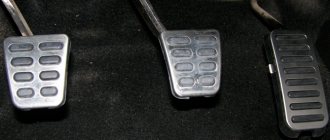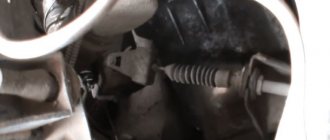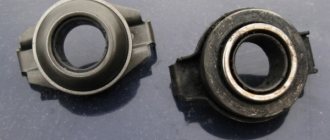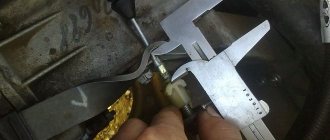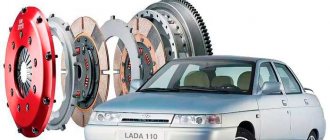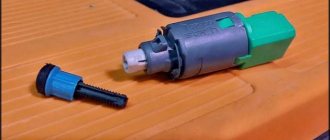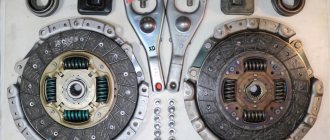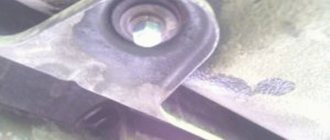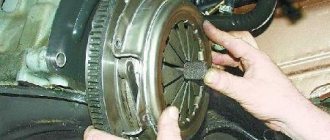The main task of the clutch is to temporarily separate (uncouple) the engine and transmission and smoothly connect them. These operations are necessary while driving to control a manual transmission: shifting gears, stopping, braking, starting the car.
If the adjustment of the free play of the clutch pedal is disrupted, the car stops moving normally, various problems arise - it becomes impossible to move away, gears are switched with a crunch, and the car may also slip and accelerate poorly.
How to adjust the clutch. General leadership
Checking the clutch cable clearance . Depending on the make of the car, the cable play on a mechanical clutch can be checked and adjusted in different ways.
There are three main ways:
- changing cable length when the clutch lever is operating;
- measuring the distance between the adjusting nut and the fork;
- measuring the distance between the adjusting nut and the cable stopper.
Some vehicles can use either of these methods. But the measurement must be carried out between the points given in the car manual or in the operating instructions.
Checking and adjusting the clutch fork . The vehicle must be securely raised on ramps or stands. We also use the handbrake to lock the wheels.
- We find the clutch cable coming down from the clutch pedal and protruding through the clutch control lever. There are threaded bushings with two nuts that are located on the protruding end of the cable.
- The clearance has a difference between the measurement when the shift lever is at rest and when it is in the inward position.
- To measure it, hold a ruler near the cable between the control lever and another reference point, such as the edge of the clutch housing.
- Gently press the lever all the way, align the ruler with its end and measure the distance between the lever and the reference point.
- Pull the lever outward and measure the distance again. We find the difference between the two measurements and compare it with the specified data from the manufacturer.
- If the gap needs to be adjusted, loosen the union nut on the threaded bushing, which is popularly called a lock nut (on some VW cars this is a wing nut).
- Next, turn the adjusting nut forward or backward to decrease or increase the gap, checking the measurement as necessary.
- Tighten the locknut and press the clutch pedal several times. Check the gap again and adjust if necessary.
On some vehicles with underbody protection, it can be very difficult to reach the locknut and turn it if necessary. In this case, you will need a special wrench that has a socket and a universal disk to perform this procedure.
Gap measurement . We measure the distance between the operating lever clutch and a reference point, such as the edge of the clutch housing. The first operation is carried out with the control lever at rest, and then when it is in the pressed position. The difference between these two measurements is the amount of free play of the lever on the cable. This is the gap in the clutch cable.
Another way to check and adjust . We find the place where the clutch cable protrudes beyond the fork and the nuts on the threaded bushing.
- Use pliers to unhook the release spring from the clutch fork.
- We take the threaded end of the cable (if necessary, you can take pliers) and tighten it to the possible level, which will allow you to raise the clutch pedal to the limit.
- You can measure the distance between the adjusting nut and the inner edge of the clutch fork coupling with a ruler. This is the clearance measurement.
- We compare the data obtained with the figure specified in the vehicle’s operating instructions.
- If there is a need for adjustment, this can be done as described above.
Checking and adjusting the clutch cable . This method is used on some older cars.
- In the fully raised position, use a block of wood to jam the clutch pedal.
- Having found the location of the clutch cable, we find where the outer cable is pressed against the edge of the housing.
- The locknut and adjustment nut are located at the end of the cable, next to the retaining bracket.
- Hold the outer part of the cable and pull it back until it stops, which will expose the inner cable.
- Using a ruler, measure the length of the exposed part of the cable between the end of the cable and the adjusting nut. This is the clutch cable clearance measurement.
- We compare the obtained data with the data specified by the manufacturer and, if necessary, adjust.
- Loosen the lock nut and turn the adjusting nut either back or forward to obtain the optimal value.
- Tighten the locknut and measure again.
Checking and adjusting the hydraulic clutch . Many hydraulic couplings are self-adjusting, but some designs allow manual adjustment to compensate for friction plate wear.
- If the fluid coupling is adjustable, the pushrod on the slave cylinder will be threaded and equipped with a lock nut.
- We lift the car securely onto the ramp or axle stands.
- We climb under the car and find the clutch slave cylinder and its adjustable pusher.
- Use pliers to unhook the release spring from the fork. Push the clutch fork forward until it stops.
- Holding it in this position, use a ruler to measure the distance between the end of the working cylinder body and the clutch fork.
- We release the fork, and then measure the distance again while it is at rest.
- The difference between these two measurements is the clutch clearance. We compare this with the number given in the car manual and adjust it if necessary.
- The locknut and adjusting nut are located on the threaded end of the pusher. Loosen the locknut.
- We turn the adjusting nut screw towards the working cylinder to increase the clearance, or towards the clutch fork to reduce it. When the measurement is correct, tighten the locknut.
- We check it again and, if necessary, adjust it again.
How to adjust the clutch on a VAZ 2110, 2111, 2112
1). Place the car on a level surface and apply the parking brake. Open the hood and disconnect the negative terminal from the battery.
Video “Adjusting the clutch drive”
This video shows the process of adjusting the clutch on VAZ cars, including Priora.
I haven’t written anything for a long time, I’ve been busy at university. And the little one just had no time for it. In short, the clicking clutch pedal got me. And it would be fine if it just clicked, it could still be tolerated, but the fact that the gearbox worked poorly did not suit me at all. The gears turned on terribly. The clutch was not particularly tight. The pleasure of driving has faded away. It's not a good idea to drive like that. I started to figure it out. Back then I didn’t know that Priors have a clutch cable with a ratcheting mechanism. I thought that it was the same here as in the VAZ 10 family. I reached under the hood to tighten the cable. I pulled it up a little. I noticed that the clutch pedal did not rise at all. Hm. The first time I press the pedal, I hear a familiar click. I rode around a bit. It seems to have gotten a little better, but still not the same. Well, that's not how a checkpoint should work. I got on the computer. It turned out that almost every second priority breeder has this problem. Kaliny seems to have the same problem. The Internet says that you need to modify the cable, install some springs, come up with something... In the end, it is not a fact that there will be a 100% effect. Not our option. There was also advice to simply replace the cable with a new one. But something told me that there was a problem in the cable. What kind of cable is this interesting? In general, the engineers’ initial idea was not bad, but they ruined everything again)) It’s all about the ratchet mechanism. Its design is such that it chooses the clutch cable tension itself. With increasing mileage, the clutch inevitably wears out little by little, and the adjustment in the well-functioning mechanism gradually disappears. And you have to tighten the cable. Here this problem was solved by installing a ratchet mechanism. In theory, he should do it himself. Everything seems to be fine, but this GAD doesn’t regulate a damn thing properly))) A regular VAZ 2110 clutch cable came to our aid. Here are two cables in comparison
How to adjust the clutch on a VAZ 2108, 2109, 2199
1). When the pedal is released, you need to use a tape measure to measure the distance from the floor to its lower edge. It should be within 18-20 centimeters.
2). Next, press the pedal with your hand all the way to the stop and measure the distance from the floor, again to the bottom edge. It should be within 6-7 centimeters.
3). From the first result obtained, 18-20 cm, we subtract the result of the second measurement, 6-7 cm. As a result, we get 13-14 cm. For cars of the VAZ 2108 and VAZ 2109 brands, this value is considered normal.
4). If this value differs in one direction or another, you will need to readjust the clutch. That is, we either tighten it up or weaken it.
5). We hold the adjusting nut with one wrench, and with the second we slightly loosen the lock nut.
6). By rotating the adjusting nut clockwise, we increase the pedal stroke, and therefore it should move downward.
7). We take measurements and if the result is satisfactory, we tighten the locknut and the work can be considered complete. But if not, then you will need to do this operation again.
Video
How to adjust the clutch on a Lada Kalina?
1). Open the hood and remove the air filter. To do this, unscrew the bolts securing the air filter housing to the hood. Then disconnect the mass air flow sensor. Next, unscrew the clamp and remove the air filter housing.
2). Pull out the cable by the threaded end to the maximum possible distance. In this case, it will be necessary to overcome the resistance exerted by the spring attached to the PS.
3). Holding the cable in this position, using a caliper we measure the distance between the plastic leash and the fork lever. It should be 2.7 cm.
4). If the distance does not match, then using an open-end wrench, we either tighten or loosen the tension nut.
5). Next, we survive the clutch pedal again and take measurements again. If it was not possible to achieve the desired result the first time, you can repeat it again.
6). After the distance has been adjusted, install the air filter in place.
Video
How to adjust the clutch on a VAZ 2107
To adjust the clutch of the VAZ 2107, you need to drive onto a pit or overpass. But, if this is not possible, then we install the car on supports using a jack, observing all safety measures.
1). The free play must be adjusted so that the distance from the top position of the pedal to the stop is 0.4 - 2 millimeters. Otherwise, you will need to make adjustments. Using a 10mm wrench, unscrew the locking nut slightly and by rotating it set the required gap.
2). If the VAZ 2107 engine system provides for fuel injection, then you will need to remove the protective shield.
3). Before applying the lubricating mixture to the threads of the pusher, clean it from dirt.
4). We check the stroke of the pusher, since the stroke of the release bearing depends on it. Push the fork back all the way, the pusher stroke should be four to five millimeters. Since significant force is required, it is better to disconnect the spring from the lever.
5). The stroke of the pusher is adjusted using a 17 key. It is also necessary to restrain the pusher adjusting nut from turning, but using a “13” wrench, loosen the lock nut.
6). Fixing the pusher using the “8” key, using the “17” key we set the required 4-5 millimeters.
7). We fix the locknut.
 . We check the pedal travel, which should be approximately 30 millimeters from its top position until it turns off. If necessary, you can perform the operation again.
. We check the pedal travel, which should be approximately 30 millimeters from its top position until it turns off. If necessary, you can perform the operation again.
About working on the clutch cable on LADA Priora
Initially, on domestic passenger VAZs with a rear-wheel drive system, the clutch was engaged thanks to an ordinary hydraulic system. The principle is exactly the same as that of the brake drive: all the pressure from the main cylinder is supplied to the so-called working cylinder. Only modern cars, such as, for example, the Lada Priora we are considering, received a front-wheel drive system; the specialists of the automobile manufacturer abandoned this principle of operation of the device in question, which greatly facilitated maintenance. The company has developed a reliable and very simple system for engaging a car clutch using a cable, now it is the main one in the entire system. The principle of the rocker arm, so to speak, is applied here, that is, when pressing the lower part of the corresponding pedal while sitting in the car, its working part, located at the top, passing through the rod (the so-called base), certainly begins to go in a completely different direction, plus everything else at this time she pulls the cable straight and, of course, behind her.
How to adjust the clutch on a Gazelle?
How to adjust the clutch on a Lada Priora?
There are two ways to measure the required position of the cable.
The first method is to orientate along the clutch pedal, the movement of which should be within 125 - 123 millimeters. But the second method is to measure the length of the cable coming out of the casing. When released, it should be 27 millimeters.
In most cases, drivers use the first option, which is explained by greater reliability. It is the procedure for the first option that we will describe in detail.
1). Using a 17mm wrench, unscrew the locknut that secures the cable casing in the box socket.
2). Next, in order to achieve the required pedal travel in the mentioned range, unscrew or tighten the second one.
3). Using a threaded plastic end cap, we correct the sag of the cable. We fasten without tightening the nuts and check for softness of gear engagement. If the clutch is adjusted correctly, the nuts can also be fixed.
How to adjust the clutch on a Lada Granta?
How to adjust the clutch on a VAZ 2114, 2115
1). Tighten the handbrake and remove the battery for safety.
How to replace a broken clutch cable
Over time, with a high mileage of the car (70-75 thousand km), the cable gradually begins to fail. Since it works in tension, it wears out over time and threatens to break. If it breaks, the machine will stop. The cable can also simply become deformed from loads.
You can understand that the life of the cable is coming to an end by two signs:
- the pedal sticks;
- The pedal goes almost to the floor.
If you notice this behavior, you should replace the cable as soon as possible. It is most convenient to carry out a scheduled replacement along with other consumables - filters, oils, brake fluid - approximately once every 70 thousand kilometers.
For repairs you will need a 8mm wrench, pliers, a ruler and a new cable. To replace the cable, you need to do the following:
- Unscrew the nut securing the cable to the pedal bracket.
- Release the pin from the stop.
- Use pliers to grab the bracket and, pulling it, remove it from the pedal.
- Separate the pedal from the axle and remove the axle itself.
- Using the jaws of the pliers, engage the tip stopper, pull it out and remove it from the pedal.
- Under the hood, remove the cable seal by pulling it in the direction of travel.
- Unhook the end of the cable from the clutch fork, similarly moving it in the direction of travel.
- Put the old cable aside and take a new one.
- Insert the cable through the hole in the front shield, then secure the wear compensation mechanism to the pedal.
- Secure the shell stop to the pin where the pedals are attached.
- Install the seal on the cable.
- Screw in the leash from the lower end of the cable.
- Insert the cable into place and attach it to the clutch fork.
The clutch cable for domestic cars is inexpensive. You can easily replace it in your garage, but if you do not have such skills, then a car service center will quickly and cheaply perform this procedure. The cable itself costs 400 rubles, and the replacement cost is about 500.
How to adjust the clutch on a Niva?
Conclusion
Although the adjustment work is not a difficult task, it requires some attention and patience. However, with the right approach, success will not keep you waiting. Good luck with the renovation.
A vehicle often requires adjustments to various controls and systems. For example, you may need to adjust the clutch pedal, which greatly affects the quality of driving a car with a manual transmission. This adjustment is quite easy to do without visiting service centers, and does not require any special knowledge or tools.
How to adjust the clutch
Operating any car involves caring for it. But, without knowing the instructions and doubting the correctness of your actions, you should not climb under the hood of the car. The article will tell you how to adjust the clutch of a MAZ truck.
Clutch device
In a MAZ car, the clutch is dry, double-disc, friction-type with cylindrical springs located along the periphery. It is installed in a cast iron crankcase. It is designed to briefly separate the engine crankshaft from the gearbox, as well as to smoothly connect them while the car is moving away and during further gear changes.
When is clutch adjustment needed?
It is necessary to pay attention to the behavior of the car when changing gear. If, at the beginning of the movement, jerks or slight impacts are felt, or noise is heard when changing gears, then you need to check the free play of the vehicle's clutch pedal.
To do this, the engine starts and the clutch pedal is gradually released from the previously released state. If the car starts moving immediately after the pedal starts to be released, it will not have free play. If the pedal is released all the way, but the car does not move or begins to move only at the very end, then it means that the pedal travel limit has been exceeded.
Thus, if there is a violation of the clutch pedal free play adjustment, normal movement of the vehicle becomes impossible. Problems arise - you can’t get going, you can hear a crunching sound when changing gears, the car slips and has poor acceleration.
How to determine the amount of free play?
Determining the amount of free play is carried out using a ruler or caliper, the main thing is that they fit in size:
- A clearly visible object with a sharp end, for example, a match, is attached to the middle of the pedal sole. This is done in order to facilitate the measurement process.
- The ruler is installed in the plane of movement of the pedal support pad so that changes in the location of the latter can be easily monitored using the scale marked on the ruler.
- Lightly press the pedal with your hand, and then carefully move it until a sharp jump in resistance to the force occurs. After this, use a match to mark the distance traveled by the pedal in millimeters.
After receiving the measurement results, it will be possible to determine whether the clutch pedal requires adjustment or whether it can be done without it.
Reference! For different car models, the value of this indicator will be different. For example, for a VAZ-2101 it will be 35-40 mm, and for modern class B cars this parameter should be in the range from 5 to 14 mm.
Thus, the specific amount of pedal travel for a certain type of car must be checked in the operating manual (the so-called “Murzilka”).
Adjusting the free play of the clutch pedal
Clutch drives can be either cable or hydraulic. Therefore, their adjustment is carried out in various ways.
Adjusting the drive with a cable
If the clutch in the car is mechanical, it is necessary to adjust the cable (cable drive). To do this, you need to get to the adjusting bolt located in the engine compartment. First, unscrew the lock nut, and then begin to rotate the adjusting nut. The result is checked with a new amplitude measurement (after pressing the clutch pedal 3 times).
The adjustment itself is carried out as follows:
- Using measuring instruments, they find out what distance separates the clutch release fork from the end of the damper. It should be no more than 8.6 cm. In this case, the error should not be more than 5 mm, either in the direction of increase or decrease.
- Find the distance at which the cable tip is located from the end of the damper. This figure should be about 6 cm, with the same error as in the previous case.
- If the distance does not correspond to normal, the cable is adjusted using an adjusting nut, which is turned in one direction or another until the desired result is achieved.
- Ultimately, the clutch pedal is pressed several times, and then new distance measurements are taken. If necessary, adjustments are made again. After this, the locknut is finally tightened.
Sometimes the cable fails completely and may need to be replaced. In a garage environment, this is not as difficult to do as it might seem to a beginner. All you need for this is to purchase a spare clutch cable, as well as a set of keys and screwdrivers.
To begin, remove the plastic parts of the car floor in the area of the pedals. This is necessary in order to have easy access during repairs to the place where the cable is connected to the pedal.
Then you need to perform the following manipulations:
- The tip of the clutch cable is disconnected from the release fork.
- Then I pull out the cable sheath damper from the mount, which is located in the gearbox housing.
- After this, the cable tip and the clutch pedal are disconnected.
- Pull out the clutch cable.
To install a new cable in place, all the above steps are performed in reverse order.
Adjusting the hydraulic drive
Before adjusting the hydraulic drive, you must first make sure that there is no air in the system. This is checked as follows: if there is no air in the system, when you press the clutch pedal it should not be soft, and after the foot pressure is removed from the pedal, it should return to its original position.
With a hydraulic clutch, the full travel of the pedal is adjusted from inside the car using a stop screw. In this case, the free play should be no more than 15 mm. The adjustment is made by rotating the master cylinder pusher rod. After all the settings have been made, you need to tighten the locknuts tightly.
Clutch cable adjustment
Before making adjustments, you need to prepare the car. For convenience, it is recommended to remove the air filter housing.
- Pull out the clutch cable with force and hold it in this position.
- We measure the distance with a caliper or a ruler between the plastic nut of the clutch guide and the release bearing drive fork. The distance should be exactly 27 mm.
- When taking measurements, there is very little space in the engine compartment and it is quite difficult to measure accurately, so it is recommended to prepare a 27 mm stick in advance and measure using it.
- Adjustment is carried out by tightening or unscrewing the plastic nut of the leash, depending on the distance between the parts.
- After completing the work, you must press the clutch pedal several times. This is necessary for the auto-adjustment mechanism to select the correct cable tension.
When adjusted correctly, the leash will fit snugly against the fork, and the clutch pedal will be 20 cm from the floor or at the level of the brake pedal
Step-by-step procedure for tensioning the clutch cable on a VAZ-2114
In order to change the length of the clutch cable, we only need a wrench.
1. First of all, open the hood and look for the nuts on the gearbox housing located at the very end of the adjustment unit. Two 17mm bolts.
The clutch cable is marked with a red marker.
2. Next, loosen the locking nut, and then change the position of the adjusting nut, tightening or unscrewing it to the required length.
The nuts will unscrew easily with any pressure.
3. When the nut is screwed on, the clutch pedal will rise, increasing the length of its distance, and if it is unscrewed, the distance to the floor will decrease, pressing the pedal closer to the floor.
The arrow marks the nut for fixing.
There is no doubt that such work is much easier to carry out in the company of an assistant.
4. Upon completion of all adjustment work, the locking nut is tightened as close to the adjusting nut as possible.
When carrying out such procedures, make sure that the clutch cable itself is intact, that there is no damage or scuffing on its body and shell, and that it moves freely inside the elements supporting it. If something like this is discovered, then it is best to replace the cable with a new one, since the wear of the supported one will only increase, and it is impossible to talk about the reliability of the work performed.
Checking work
After you have completed this work, you need to check the correctness of the work performed.
- First, measure the travel of the clutch pedal.
- With the engine turned off, depress the clutch pedal several times and return it to its place.
- Next, we take a new measurement and clarify the received readings.
- If they have not changed compared to the first measurements, then the work has been completed, correctly, and the first stage of verification can be considered completed.
- And if they differ from the first indicators, it means that the locking nut was not tightened tightly, and the adjustment process must be carried out again.
There is one rule among car enthusiasts! A properly adjusted clutch should begin to engage approximately halfway through the pedal stroke.
The following test can definitively indicate the serviceability and correctly adjusted clutch:
- The car must be placed on a flat surface, the handbrake must be turned on, and the engine must be running.
- Next, we turn on the gear and try to start moving.
- If at this moment, when the clutch pedal is not pressed, the car stalls, this means that the adjustment was made correctly.
- And if this does not happen, the car is running in gear with the clutch pedal not pressed, then this will indicate clutch slipping, which will need adjustment.
Clutch VAZ 2115
- Phillips screwdriver or No. 8 head;
- set of open-end wrenches for 13 and 17;
- WD 40 or similar product;
- ruler/construction tape measure/other measuring instrument.
Replacement
a set of serviceable clutch parts for VAZ 2114; sets of spanner and socket wrenches; mandrel; jack.
Let's move on to replacement.
First of all, you need to jack up the car. An inspection hole and overpass are ideal for this purpose.
Remove the front wheels.
Disconnect the ground wire, drive and speedometer cables from the gearbox. It is not necessary to disconnect the cables, but it is worth doing for convenience.
We also disconnect the gear shift drive and the support from the gearbox side.
Use your hands to unscrew the lower casing that protects the flywheel. Inspect the condition of the flywheel. If we notice significant cracks and other defects on its surface, it means it is faulty. Remove (by hand).
Using a size 7 spanner, unscrew the bolts that secure the ball joints. As a rule, there are only 3 of them.
If we are making a complete, rather than selective, replacement, we disconnect the drive shafts from the gearbox and drain the oil. After which you can carefully remove the gearbox.
We unscrew the bolts that secure the gearbox to the cylinders. It is most convenient to use a socket wrench size 8.
Using a size 8 spanner, unscrew the bolts securing the pressure plate to the flywheel.
Remove the pressure and driven discs. The pressure plate is also called the basket. At this stage, you need to make sure that it is working properly. Otherwise, replacement will be required. The working surface should not have cracks or large gaps.
We pry up the ends of the return spring that secures the release bearing.
Remove the clutch, bearing and return spring. We inspect each of the parts in order to understand which ones should be replaced. We twist the bearing in our hand. If you hear a crunching or noise, the bearing is bad, we are preparing a new one for replacement.
Remove the switch plug. We treat the parts with kerosene; if any of the parts are in good condition and do not need to be replaced, we carry out a selective replacement rather than a complete one.
We clean the gearbox input shaft from various dirt and old grease.
We return (or attach a new one) the release bearing, clutch and return spring.
To center the crankshaft, insert a mandrel into its hole. Then we install the driven disk on the mandrel.
We screw it with bolts (with a spanner onto the pressure plate (basket) into the flywheel.
the pressure plate (basket) into the flywheel.
Further installation is carried out in reverse order.
Adjustment
Initially, it is worth measuring the pedal deviation from the norm. To do this, you need to push the drive to the maximum, then release it. It is necessary to measure the stroke length - the distance from the center of the pedal pad in its lower position, when it is resting on the floor, and in its upper position. If the deviation from the normal length is significant, the pedal should be adjusted.
Deviations from the norm can be detected without measurements. To do this, you need to place the car on a flat horizontal surface, engage first gear and, smoothly releasing the drive, start moving. If the car starts moving only at the end of pressing the pedal, debugging is necessary.
In order to adjust the drive of the VAZ 2115, it is necessary to change the length of the cable jacket. To do this, you need to loosen or tighten the two nuts with which it is attached to the bracket.
Open the hood. Remove the air filter. We find the cable and nuts that secure it to the bracket. They are located on its threaded part. Unfortunately, on the VAZ 2115 these parts are located inconveniently. When manipulating the nuts, the length of the cable jacket changes. In order to reduce the stroke, loosen the nut located inside the bracket and tighten the nut outside, and vice versa, if you need to increase it.
If the threads are rusty, you can use liquid to make the threads easier to remove. If there is none, you can use engine oil or brake fluid.
After debugging, you should check changes in the operation of the node. This should be done in the same way as during the initial check for deviation from the norm. After correct adjustment, the stroke does not exceed 135 mm. If the procedure does not lead to anything and the clutch of your VAZ 2115 continues to slip, then the element has become unusable and needs to be replaced.
Watch a video about replacing the clutch on a VAZ 2115 car on our website.
As a vehicle ages, all its main components and mechanisms also wear out. For this reason, it is extremely important to periodically inspect the machine - this will allow you to identify the problem in time and fix it before it leads to a more serious breakdown.
Timely adjustment and inspection of the clutch on the VAZ-2115 will avoid failure of this unit and eliminate the need to replace it. In a car service, as you know, this procedure is not cheap, and it takes a lot of time.
At the same time, an improperly adjusted clutch makes driving uncomfortable for the driver.
In this material we will tell you in detail exactly how to correctly perform this operation and the sequence in which to perform all the necessary actions.
Design
The mechanical drive on the VAZ-2114, despite the fact that it has the least simple design, is in no way inferior in reliability to its hydraulic counterpart. Its system consists of a cable adjustable in length, sealed in a special anti-corrosion sheath, and the clutch pedal itself located in the car's interior, which, through free movement, is designed to transmit the pressing force to the clutch fork.
Despite the fact that such a scheme is simple, in general it is quite reliable.
Clutch diagram
A new product in the form of a clutch cable for VAZ-2114 cars helped to avoid all the problems that all owners of classics encounter. First of all, this refers to the leakage of hydraulic fluid from the system, and as a result, loss of control over the car. It would also require work to remove air from the clutch system after repair.
At the same time, periodic checking and adjustment of the clutch pedal has remained the same.
Why is it necessary to adjust the cable travel?
This procedure is necessary so that when the pedal, and with it the clutch cable, reaches certain values, the most squat pressing of the flywheel with the basket to the driven disk is made, at the moment when its operation is necessary. At the same time, thanks to the precise adjustment of this drive, the clutch is released at the moment the clutch pedal is released.
Note! During operation of this system, when the lever is in the neutral position, or when it is turned on, no extraneous sounds or crackles should come from the gearbox housing.
You can monitor the condition of the clutch, preventing such a situation from occurring, visually by positioning the clutch pedal relative to the floor of the car, using only a ruler.
Values
The optimal values should be from 125 to 140 mm , when measuring readings first with the pedal pressed and then with the pedal released. The maximum value that is allowed when measuring such indicators is 160 mm , and if they exceed these values, then this will mean severe wear of the friction linings, and therefore, after adjusting it, the clutch itself may soon need to be replaced.
We measure the result along the bottom edge of the pedal - in the photo the result is normal.
Structure and functions of clutch
The mechanical drive of the VAZ 2114, when compared with hydraulics, has a much simpler, but equally durable design. It consists of:
- cable, adjustable in length in the sheath;
Cable location - pedals that control the clutch from the passenger compartment;
- a device that controls the position and free play of the pedal;
- lever structure that transmits force from the pedal to the clutch fork.
The introduction of a cable into the design of the VAZ 2114 made it possible to eliminate complications with hydraulics, for example, very frequent leakage of fluid.
In a VAZ 2114 car, the clutch is a simple unit in design. The system is equipped with a special cable, which, compared to a hydraulic unit, does not require constant maintenance. And you can change this element yourself if necessary.
The drive includes the following parts:
- cable for changing position in a special shell;
- a pedal that the driver controls from inside the car;
- clutch shift fork handle;
- a clamp securing the tip of the cable sheath;
- brake and clutch pedal retainer.
The mechanism is designed to transmit force from the pedal in the car interior to the fork in the engine compartment. This element removes the friction shaft from the flywheel of the power unit. Thanks to the use of cable transmission, AvtoVAZ engineers have ensured that the driver will not encounter problems with oil leakage or the need to remove air pockets from the clutch control system.
In VAZ 2114 cars, the cable is considered the weakest component, so car owners are often faced with the procedure of replacing it. If you correctly install and tighten the cable when adjusting, this will ensure that the driven pulley is pressed well against the flywheel of the machine motor and basket when the clutch is activated.
Clutch device in VAZ 2114
The principle of clutch adjustment
If, after a preliminary check, you have determined that the clutch cable needs adjustment (that is, tightening - approx.), then do not be alarmed, since the process of such work is not complicated and will not require any additional effort.
Clutch cable tension is adjusted by tightening it under the hood
Such a process consists of simply changing the length of the cable and its sheath from the adjustment unit, due to which its indicators can change both to the smallest and greatest extent.
As you might have guessed, if the length of the cable is reduced, then the pedal stroke will be less, the same applies to increasing the stroke, all that remains is to achieve those cherished pedal stroke indicators of 12.5 centimeters.
Clutch cable device in Priora
In order for the drive to work properly and stably, the core (cable) is located inside a special casing, completely fixedly fixed. As mentioned above, one end of the cable is attached to the clutch fork, as you understand, on the gearbox, and the other end is located in the cabin near the pedal. Each end is equipped with a fastening device. The ends are very different from each other, and it is simply impossible to confuse them in any way. There is also a rubber coupling; it is installed in the body in the hole where the cable goes into the compartment where the engine is located from the car interior.
So, the device consists of the following elements:
- In duplicate, fasteners for the casing.
- Clutch cable.
- Fastening element for fork.
- There is a special loop for the pedal.
- Rubber casing to protect the interior opening.
As you already understand, the core is located inside a hard shell, where it moves under the influence of return springs and the pedal itself. Thanks to this, its stable operation is ensured.
